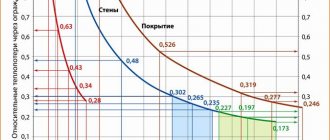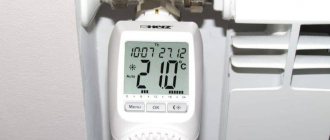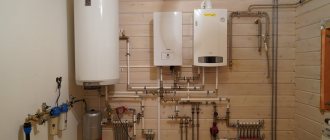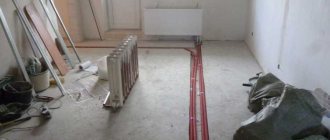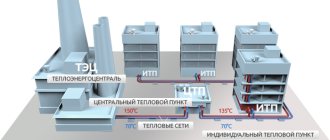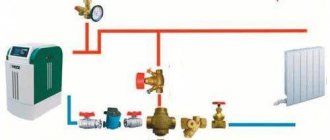Design and thermal calculation of a heating system is an obligatory stage when arranging home heating. The main task of computing activities is to determine the optimal parameters of the boiler and radiator system.
Agree, at first glance it may seem that only an engineer can carry out thermal engineering calculations. However, not everything is so complicated. Knowing the algorithm of actions, you will be able to independently perform the necessary calculations.
The article describes in detail the calculation procedure and provides all the necessary formulas. For a better understanding, we have prepared an example of a thermal calculation for a private home.
Standards for room temperature conditions
Before carrying out any calculations of system parameters, it is necessary, at a minimum, to know the order of the expected results, and also to have standardized characteristics of some tabular values that need to be substituted into formulas or be guided by them.
By calculating parameters with such constants, you can be confident in the reliability of the desired dynamic or constant parameter of the system.
For premises of various purposes, there are reference standards for temperature conditions in residential and non-residential premises. These standards are enshrined in the so-called GOSTs
For a heating system, one of these global parameters is the room temperature, which must be constant regardless of the season and environmental conditions.
According to the regulations of sanitary standards and rules, there are differences in temperature relative to the summer and winter periods of the year. The air conditioning system is responsible for the temperature regime of the room in the summer season; the principle of its calculation is described in detail in this article.
But the room temperature in winter is provided by the heating system. Therefore, we are interested in temperature ranges and their deviation tolerances for the winter season.
Most regulatory documents stipulate the following temperature ranges that allow a person to stay comfortably in the room.
For non-residential office premises with an area of up to 100 m2:
- 22-24°C – optimal air temperature;
- 1°С – permissible fluctuation.
For office-type premises with an area of more than 100 m2, the temperature is 21-23°C. For non-residential industrial premises, temperature ranges vary greatly depending on the purpose of the room and established labor protection standards.
Each person has their own comfortable room temperature. Some people like it to be very warm in the room, others feel comfortable when the room is cool - it’s all quite individual.
As for residential premises: apartments, private houses, estates, etc., there are certain temperature ranges that can be adjusted depending on the wishes of the residents.
And yet, for specific premises of an apartment and house we have:
- 20-22°С – living room, including children’s room, tolerance ±2°С –
- 19-21°С – kitchen, toilet, tolerance ±2°С;
- 24-26°С – bathroom, shower, swimming pool, tolerance ±1°С;
- 16-18°C – corridors, hallways, staircases, storerooms, tolerance +3°C
It is important to note that there are several more basic parameters that affect the temperature in the room and which you need to focus on when calculating the heating system: humidity (40-60%), concentration of oxygen and carbon dioxide in the air (250:1), air movement speed mass (0.13-0.25 m/s), etc.
Example No. 1
One common device is installed in a residential building, and there are no individual devices in the premises. When deciding how to calculate heating in an apartment, we note that the payment for heating in a residential premises is carried out according to formula No. 3 of the Rules based on the readings of the individual heating meter installed in the apartment, or the heat consumption standard established for heating in residential premises type. All device readings are taken into account in Gcal.
- The volume of heat according to the data of the common house appliance was 250 Gcal.
- The total area of the house, which includes all apartments, as well as non-residential premises, is 7000 sq. m. meters.
- Apartment area – 75 sq.m. meters.
- The tariff for heat energy is 1,400 rubles. for 1 Gcal.
Heating calculations based on the area of the apartment will be made using the following scheme:
250 * 75 / 7000 * 1400 = 3750 rubles
This was the calculation of the first component of the receipt; the second component will be calculated using formulas No. 10 and No. 14. The first formula calculates the volume of the service, and the second formula calculates the amount of the fee in rubles. To determine the volume, you need to take into account the area of non-residential premises and apartments. For example, the size of the area is 6000 sq. meters.
The amount of heat will be produced by the following calculation:
250 * (1-6000 / 7000) * 75 / 6000 = 0.446428571 Gcal.
After these calculations, you can calculate the heating fee:
3750 + 625 = 4375 rub.
Installation of a heat meter in the basement of an apartment building
Calculation of heat loss in the house
According to the second law of thermodynamics (school physics), there is no spontaneous transfer of energy from less heated to more heated mini- or macro-objects. A special case of this law is the “striving” to create temperature equilibrium between two thermodynamic systems.
For example, the first system is an environment with a temperature of -20°C, the second system is a building with an internal temperature of +20°C. According to the above law, these two systems will strive to balance through the exchange of energy. This will happen with the help of heat losses from the second system and cooling in the first.
We can definitely say that the ambient temperature depends on the latitude at which the private house is located. And the temperature difference affects the amount of heat leakage from the building (+)
Heat loss refers to the involuntary release of heat (energy) from some object (house, apartment). For an ordinary apartment, this process is not so “noticeable” in comparison with a private house, since the apartment is located inside the building and “adjacent” to other apartments.
In a private house, heat “leaks” to one degree or another through the external walls, floor, roof, windows and doors.
Knowing the amount of heat loss for the most unfavorable weather conditions and the characteristics of these conditions, it is possible to calculate the power of the heating system with high accuracy.
So, the volume of heat leakage from the building is calculated using the following formula:
Q=Qfloor+Qwall+Qwindow+Qroof+Qdoor+…+Qi , where
Qi is the volume of heat loss from a homogeneous type of building shell.
Each component of the formula is calculated using the formula:
Q=S*∆T/R , where
- Q – heat leakage, V;
- S – area of a specific type of structure, sq. m;
- ∆T – difference in ambient and indoor air temperatures, °C;
- R – thermal resistance of a certain type of structure, m2*°C/W.
It is recommended to take the very value of thermal resistance for real existing materials from auxiliary tables.
Additionally, the thermal resistance can be obtained using the following relationship:
R=d/k , where
- R – thermal resistance, (m2*K)/W;
- k – coefficient of thermal conductivity of the material, W/(m2*K);
- d – thickness of this material, m.
In old houses with damp roofing structures, heat leaks occur through the upper part of the building, namely through the roof and attic. Taking measures to insulate the ceiling or insulate the attic roof solves this problem.
If you insulate the attic space and roof, the overall heat loss from the house can be significantly reduced
There are several other types of heat loss in the house through cracks in structures, ventilation systems, kitchen hoods, and opening windows and doors. But it makes no sense to take into account their volume, since they constitute no more than 5% of the total number of main heat leaks.
Accurate calculation of heat loss
Using a special value that characterizes heat flow and is measured in kcal/hour, the heat loss of a house is determined.
This value shows how much heat is lost through the walls of the building at a certain temperature condition inside the house.
This indicator is considered in direct dependence on the architectural features of the building, the building materials from which it is constructed, the thickness and degree of thermal insulation of the walls, ceiling and floor. The glazing area, the quality of heat insulators and adherence to technology during their installation are influenced.
That is, heat loss consists of many elements.
The formula is as follows: G = Sх1/Pох(Тв-Тн)к, where:
- G is the value expressed in kcal/h;
- Po is an indicator of resistance to heat transfer;
- Тв иТн - difference in temperature conditions inside and outside;
- k is a coefficient that shows how much heat is lost; it is different for each barrier.
Since the temperature outside and indoors changes during the heating season, the values are taken as average. The fact that each region with different climatic conditions has its own indicator is also taken into account.
This formula uses specific quantities, all of which are known. Using it you can find out the heat losses of any building.
The reduction factor and resistance value Po belong to the category of normative and reference information.
For example, the following coefficients may be needed:
- 1 - if there is soil or wooden logs under the finished floors;
- 0.9 - for attic floors, where the roofing material is steel, tiles on sheathing, asbestos cement (or a roof without an attic with ventilation);
- 0.8 - the roofing materials are the same, but the flooring is solid;
- 0.75 - attic floors, where the roof is made of any rolled material;
- 0.7 - for internal walls that open into an adjacent unheated room without external walls;
- 0.4 - for internal walls that connect to an adjacent unheated room that has external walls, and for floors above a cellar deepened into the ground;
- 0.75 - floors above the cellar, located above the ground;
- 0.6 - surfaces above basements located either below the ground or no higher than one meter above it.
- Similarly, you can select coefficients for other situations.
The following resistance values may be needed:
- 0.38 - with solid brickwork with a wall thickness of 13.5 cm, 0.57 - with a masonry thickness of 26.5 cm, 0.76 - 39.5 cm, 0.94 - 52.5 cm, 1.13 - 65.5 cm.
- 0.9 - with continuous masonry with an air gap with a thickness of 43.5 cm, 1.09 - 56.5 cm, 1.28 - 65.5 cm;
- 0.89 - with continuous masonry of decorative bricks with a thickness of 39.5 cm, 1.2 - 52.5 cm, 1.4 - 65.5 cm.
- 1.03 - for solid masonry, where the thermal insulation layer is 39.5 cm thick, 1.49 - 52.5 cm;
- 1.33 - for wooden walls made of wood (not timber) with a thickness of 200 mm, 1.45 - 220 mm, 1.56 - 240 mm;
- 1.18 - for walls made of timber with a thickness of 150 mm, 1.28 - 180 mm, 1.32 - 200 mm;
- 0.69 - for attic floors made of reinforced concrete slabs with insulation with a thickness of 100 mm, 0.89 - 150 mm.
These indicators are taken for the formula for water consumption for heating.
Determination of boiler power
To maintain the temperature difference between the environment and the temperature inside the house, an autonomous heating system is required, which maintains the desired temperature in each room of a private house.
The heating system is based on different types of boilers: liquid or solid fuel, electric or gas.
A boiler is the central unit of a heating system that generates heat. The main characteristic of a boiler is its power, namely the rate of conversion of the amount of heat per unit of time.
After calculating the heating load, we obtain the required rated power of the boiler.
For an ordinary multi-room apartment, the boiler power is calculated through the area and specific power:
Rkotla=(Spremises*Mining)/10 , where
- Spremises – the total area of the heated premises;
- Rudelnaya – specific power relative to climatic conditions.
But this formula does not take into account heat losses, which are sufficient in a private house.
There is another ratio that takes this parameter into account:
Rboiler=(Qloss*S)/100 , where
- Rkotla – boiler power;
- Qloss – heat loss;
- S – heated area.
The design power of the boiler needs to be increased. The reserve is necessary if you plan to use the boiler to heat water for the bathroom and kitchen.
In most heating systems of private houses, it is recommended to use an expansion tank in which the coolant supply will be stored. Every private home needs hot water supply
In order to provide for the boiler power reserve, the safety factor K must be added to the last formula:
Rboiler=(Qloss*S*K)/100 , where
K – will be equal to 1.25, that is, the design power of the boiler will be increased by 25%.
Thus, the boiler power makes it possible to maintain the standard air temperature in the rooms of the building, as well as to have an initial and additional volume of hot water in the house.
Results of calculations of Gcal for heating
If you have correctly calculated the consumption of Gcal of thermal energy, then you do not have to worry about overpayments for utilities. If we use the above formulas, we can conclude that when heating a residential building with an area of up to 200 sq.m. you will need to spend about 3 Gcal in 1 month. If we consider that the heating season in many regions of the country lasts approximately 6 months, then we can calculate the approximate consumption of thermal energy. To do this, multiply 3 Gcal by 6 months and get 18 Gcal.
It is much easier to calculate gigacalorie consumption in a private home, since you can install your own individual device there. In apartment buildings with centralized heating, it will not be possible to get by with a conventional appliance.
Based on the information indicated above, we can conclude that all calculations on the consumption of thermal energy in a particular house can be done independently without the help of special organizations. But it is worth remembering that all data must be calculated accurately using special mathematical formulas. In addition, all procedures must be coordinated with special bodies that control such actions. If you are not sure that you will perform the calculation yourself, then you can use the services of professional specialists who are engaged in such work and have materials available that describe in detail the entire process and photos of heating system samples, as well as their connection diagrams.
Features of the selection of radiators
Standard components for providing heat in a room are radiators, panels, underfloor heating systems, convectors, etc. The most common parts of a heating system are radiators.
The thermal radiator is a special hollow modular structure made of an alloy with high heat transfer. It is made of steel, aluminum, cast iron, ceramics and other alloys. The principle of operation of a heating radiator is reduced to the radiation of energy from the coolant into the space of the room through the “petals”.
An aluminum and bimetallic heating radiator replaced massive cast-iron batteries. Simplicity of production, high heat transfer, successful design and design have made this product a popular and widespread instrument for radiating heat indoors
There are several methods for calculating heating radiators in a room. The list of methods below is sorted in order of increasing calculation accuracy.
Calculation options:
- By area . N=(S*100)/C, where N is the number of sections, S is the area of the room (m2), C is the heat transfer of one section of the radiator (W, taken from the data sheet or certificate for the product), 100 W is the amount of heat flow, which is necessary to heat 1 m2 (empirical value). The question arises: how to take into account the height of the ceiling of the room?
- By volume . N=(S*H*41)/C, where N, S, C – similarly. H is the height of the room, 41 W is the amount of heat flow that is necessary to heat 1 m3 (empirical value).
- By odds . N=(100*S*k1*k2*k3*k4*k5*k6*k7)/C, where N, S, C and 100 are similar. k1 – taking into account the number of chambers in a double-glazed window of a room, k2 – thermal insulation of walls, k3 – ratio of window area to room area, k4 – average sub-zero temperature in the coldest week of winter, k5 – number of external walls of the room (which “extend” to the street), k6 – type of room above, k7 – ceiling height.
This is the most accurate option for calculating the number of sections. Naturally, fractional calculation results are always rounded to the next integer.
The need to calculate the thermal power of the heating system
The need to calculate the thermal energy required to heat rooms and utility rooms is due to the fact that it is necessary to determine the main characteristics of the system depending on the individual characteristics of the facility being designed, including:
- purpose of the building and its type;
- the configuration of each room;
- number of residents;
- geographical location and region in which the settlement is located;
- other parameters.
Calculating the required heating power is an important point; its result is used to calculate the parameters of the heating equipment that they plan to install:
- Selection of a boiler depending on its power
. The efficiency of the heating structure is determined by the correct choice of the heating unit. The boiler must have such a performance as to ensure heating of all rooms in accordance with the needs of the people living in the house or apartment, even on the coldest winter days. At the same time, if the device has excess power, part of the generated energy will not be in demand, which means that a certain amount of money will be wasted. - The need to coordinate connection to the main gas pipeline
. To connect to the gas network you will need technical specifications. To do this, submit an application to the appropriate service indicating the expected gas consumption for the year and an estimate of the total thermal power for all consumers. - Performing calculations for peripheral equipment
. Calculation of thermal loads for heating is necessary to determine the length of the pipeline and cross-section of the pipes, the performance of the circulation pump, the type of batteries, etc.
Hydraulic calculation of water supply
Of course, the “picture” of calculating heat for heating cannot be complete without calculating such characteristics as the volume and speed of the coolant. In most cases, the coolant is ordinary water in a liquid or gaseous aggregate state.
It is recommended to calculate the actual volume of coolant by summing all cavities in the heating system. When using a single-circuit boiler, this is the best option. When using double-circuit boilers in a heating system, it is necessary to take into account the consumption of hot water for hygienic and other domestic purposes
Calculation of the volume of water heated by a double-circuit boiler to provide residents with hot water and heat the coolant is made by summing the internal volume of the heating circuit and the actual needs of users for heated water.
The volume of hot water in the heating system is calculated by the formula:
W=k*P , where
- W – volume of coolant;
- P – heating boiler power;
- k – power factor (number of liters per unit of power, equal to 13.5, range – 10-15 liters).
As a result, the final formula looks like this:
W = 13.5*P
Coolant velocity is the final dynamic assessment of the heating system, which characterizes the speed of fluid circulation in the system.
This value helps to evaluate the type and diameter of the pipeline:
V=(0.86*P*μ)/∆T , where
- P – boiler power;
- μ – boiler efficiency;
- ∆T – temperature difference between supply water and return water.
Using the above methods of hydraulic calculation, it will be possible to obtain real parameters that are the “foundation” of the future heating system.
Heat meters
In order to calculate thermal energy you need to know the following information:
- The temperature of the liquid at the inlet and outlet of a certain section of the pipeline.
- The flow rate of liquid that moves through heating devices.
Consumption can be determined using heat meters. Heat meters can be of two types:
- Vane counters. Such devices are used to measure thermal energy, as well as hot water consumption. The difference between such meters and devices for metering cold water is the material from which the impeller is made. In such devices it is most resistant to high temperatures. The operating principle is similar for the two devices:
- The rotation of the impeller is transmitted to the metering device;
- The impeller begins to rotate due to the movement of the working fluid;
- The transfer is carried out without direct interaction, but with the help of a permanent magnet.
Such devices have a simple design, but their response threshold is low. They also have reliable protection against reading distortion. Using an antimagnetic screen, the impeller is prevented from braking by the external magnetic field.
- Devices with a difference recorder. Such meters operate according to Bernoulli's law, which states that the speed of a liquid or gas flow is inversely proportional to its static movement. If the pressure is recorded by two sensors, the flow can be easily determined in real time. The counter involves electronics in the design. Almost all models provide information on the flow and temperature of the working fluid, and also determine the consumption of thermal energy. You can configure the work manually using a PC. You can connect the device to a PC via a port.
Many residents are wondering how to calculate the amount of Gcal for heating in an open heating system in which hot water can be selected. Pressure sensors are installed on the return and supply pipes at the same time. The difference in the flow rate of the working fluid will show the amount of warm water that was spent for domestic needs.
Example of thermal calculation
As an example of a thermal calculation, we have an ordinary 1-story house with four living rooms, a kitchen, a bathroom, a “winter garden” and utility rooms.
The foundation is made of a monolithic reinforced concrete slab (20 cm), the external walls are concrete (25 cm) with plaster, the roof is made of wooden beams, the roof is metal tiles and mineral wool (10 cm)
Let us designate the initial parameters of the house necessary for the calculations.
Building dimensions:
- floor height – 3 m;
- small window on the front and rear of the building 1470*1420 mm;
- large facade window 2080*1420 mm;
- entrance doors 2000*900 mm;
- rear doors (exit to the terrace) 2000*1400 (700 + 700) mm.
The total width of the building is 9.5 m2, length 16 m2. Only living rooms (4 units), a bathroom and a kitchen will be heated.
To accurately calculate heat loss on the walls, you need to subtract the area of all windows and doors from the area of the external walls - this is a completely different type of material with its own thermal resistance
We start by calculating the areas of homogeneous materials:
- floor area – 152 m2;
- roof area – 180 m2, taking into account the attic height of 1.3 m and the purlin width – 4 m;
- window area – 3*1.47*1.42+2.08*1.42=9.22 m2;
- door area – 2*0.9+2*2*1.4=7.4 m2.
The area of the external walls will be 51*3-9.22-7.4=136.38 m2.
Let's move on to calculating heat loss for each material:
- Qfloor=S*∆T*k/d=152*20*0.2/1.7=357.65 W;
- Qroof=180*40*0.1/0.05=14400 W;
- Qwindow=9.22*40*0.36/0.5=265.54 W;
- Qdoors=7.4*40*0.15/0.75=59.2 W;
And also Qwall is equivalent to 136.38*40*0.25/0.3=4546. The sum of all heat losses will be 19628.4 W.
As a result, we calculate the boiler power: Rboiler = Qloss * Room heating * K / 100 = 19628.4 * (10.4 + 10.4 + 13.5 + 27.9 + 14.1 + 7.4) * 1.25/100 = 19628.4 * 83.7 * 1.25/100 = 20536.2 = 21 kW.
We will calculate the number of radiator sections for one of the rooms. For all others, the calculations are similar. For example, a corner room (on the left, lower corner of the diagram) has an area of 10.4 m2.
This means N=(100*k1*k2*k3*k4*k5*k6*k7)/C=(100*10.4*1.0*1.0*0.9*1.3*1.2*1.0*1.05)/180=8.5176=9.
This room requires 9 sections of heating radiator with a heat output of 180 W.
Let's move on to calculating the amount of coolant in the system - W=13.5*P=13.5*21=283.5 l. This means that the coolant speed will be: V=(0.86*P*μ)/∆T=(0.86*21000*0.9)/20=812.7 l.
As a result, a complete turnover of the entire volume of coolant in the system will be equivalent to 2.87 times per hour.
A selection of articles on thermal calculations will help you determine the exact parameters of the heating system elements:
- Calculation of the heating system of a private house: rules and calculation examples
- Thermal engineering calculation of a building: specifics and formulas for performing calculations + practical examples

